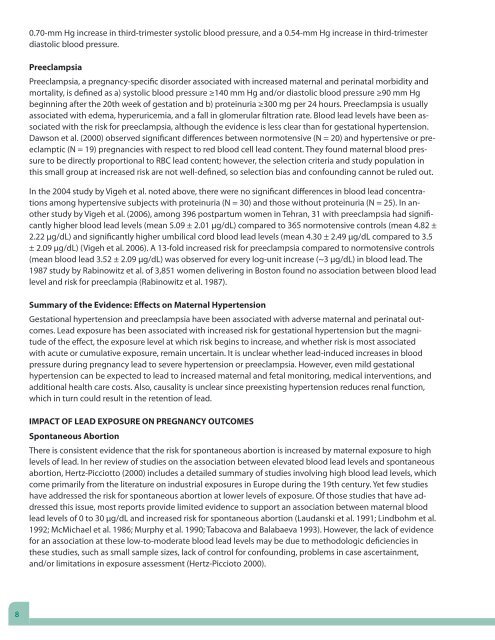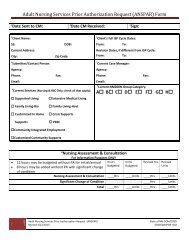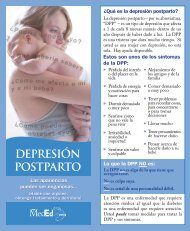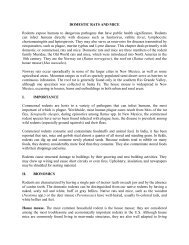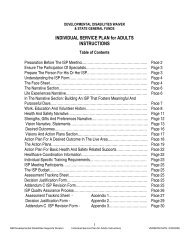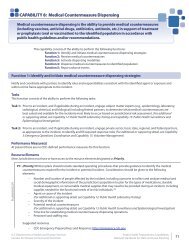Guidelines for the Identification and Management of Lead Exposure
Guidelines for the Identification and Management of Lead Exposure
Guidelines for the Identification and Management of Lead Exposure
You also want an ePaper? Increase the reach of your titles
YUMPU automatically turns print PDFs into web optimized ePapers that Google loves.
0.70-mm Hg increase in third-trimester systolic blood pressure, <strong>and</strong> a 0.54-mm Hg increase in third-trimesterdiastolic blood pressure.PreeclampsiaPreeclampsia, a pregnancy-specific disorder associated with increased maternal <strong>and</strong> perinatal morbidity <strong>and</strong>mortality, is defined as a) systolic blood pressure ≥140 mm Hg <strong>and</strong>/or diastolic blood pressure ≥90 mm Hgbeginning after <strong>the</strong> 20th week <strong>of</strong> gestation <strong>and</strong> b) proteinuria ≥300 mg per 24 hours. Preeclampsia is usuallyassociated with edema, hyperuricemia, <strong>and</strong> a fall in glomerular filtration rate. Blood lead levels have been associatedwith <strong>the</strong> risk <strong>for</strong> preeclampsia, although <strong>the</strong> evidence is less clear than <strong>for</strong> gestational hypertension.Dawson et al. (2000) observed significant differences between normotensive (N = 20) <strong>and</strong> hypertensive or preeclamptic(N = 19) pregnancies with respect to red blood cell lead content. They found maternal blood pressureto be directly proportional to RBC lead content; however, <strong>the</strong> selection criteria <strong>and</strong> study population inthis small group at increased risk are not well-defined, so selection bias <strong>and</strong> confounding cannot be ruled out.In <strong>the</strong> 2004 study by Vigeh et al. noted above, <strong>the</strong>re were no significant differences in blood lead concentrationsamong hypertensive subjects with proteinuria (N = 30) <strong>and</strong> those without proteinuria (N = 25). In ano<strong>the</strong>rstudy by Vigeh et al. (2006), among 396 postpartum women in Tehran, 31 with preeclampsia had significantlyhigher blood lead levels (mean 5.09 ± 2.01 µg/dL) compared to 365 normotensive controls (mean 4.82 ±2.22 µg/dL) <strong>and</strong> significantly higher umbilical cord blood lead levels (mean 4.30 ± 2.49 µg/dL compared to 3.5± 2.09 µg/dL) (Vigeh et al. 2006). A 13-fold increased risk <strong>for</strong> preeclampsia compared to normotensive controls(mean blood lead 3.52 ± 2.09 µg/dL) was observed <strong>for</strong> every log-unit increase (~3 µg/dL) in blood lead. The1987 study by Rabinowitz et al. <strong>of</strong> 3,851 women delivering in Boston found no association between blood leadlevel <strong>and</strong> risk <strong>for</strong> preeclampia (Rabinowitz et al. 1987).Summary <strong>of</strong> <strong>the</strong> Evidence: Effects on Maternal HypertensionGestational hypertension <strong>and</strong> preeclampsia have been associated with adverse maternal <strong>and</strong> perinatal outcomes.<strong>Lead</strong> exposure has been associated with increased risk <strong>for</strong> gestational hypertension but <strong>the</strong> magnitude<strong>of</strong> <strong>the</strong> effect, <strong>the</strong> exposure level at which risk begins to increase, <strong>and</strong> whe<strong>the</strong>r risk is most associatedwith acute or cumulative exposure, remain uncertain. It is unclear whe<strong>the</strong>r lead-induced increases in bloodpressure during pregnancy lead to severe hypertension or preeclampsia. However, even mild gestationalhypertension can be expected to lead to increased maternal <strong>and</strong> fetal monitoring, medical interventions, <strong>and</strong>additional health care costs. Also, causality is unclear since preexisting hypertension reduces renal function,which in turn could result in <strong>the</strong> retention <strong>of</strong> lead.IMPACT OF LEAD EXPOSURE ON PREGNANCY OUTCOMESSpontaneous AbortionThere is consistent evidence that <strong>the</strong> risk <strong>for</strong> spontaneous abortion is increased by maternal exposure to highlevels <strong>of</strong> lead. In her review <strong>of</strong> studies on <strong>the</strong> association between elevated blood lead levels <strong>and</strong> spontaneousabortion, Hertz-Picciotto (2000) includes a detailed summary <strong>of</strong> studies involving high blood lead levels, whichcome primarily from <strong>the</strong> literature on industrial exposures in Europe during <strong>the</strong> 19th century. Yet few studieshave addressed <strong>the</strong> risk <strong>for</strong> spontaneous abortion at lower levels <strong>of</strong> exposure. Of those studies that have addressedthis issue, most reports provide limited evidence to support an association between maternal bloodlead levels <strong>of</strong> 0 to 30 µg/dL <strong>and</strong> increased risk <strong>for</strong> spontaneous abortion (Laudanski et al. 1991; Lindbohm et al.1992; McMichael et al. 1986; Murphy et al. 1990; Tabacova <strong>and</strong> Balabaeva 1993). However, <strong>the</strong> lack <strong>of</strong> evidence<strong>for</strong> an association at <strong>the</strong>se low-to-moderate blood lead levels may be due to methodologic deficiencies in<strong>the</strong>se studies, such as small sample sizes, lack <strong>of</strong> control <strong>for</strong> confounding, problems in case ascertainment,<strong>and</strong>/or limitations in exposure assessment (Hertz-Piccioto 2000).8


